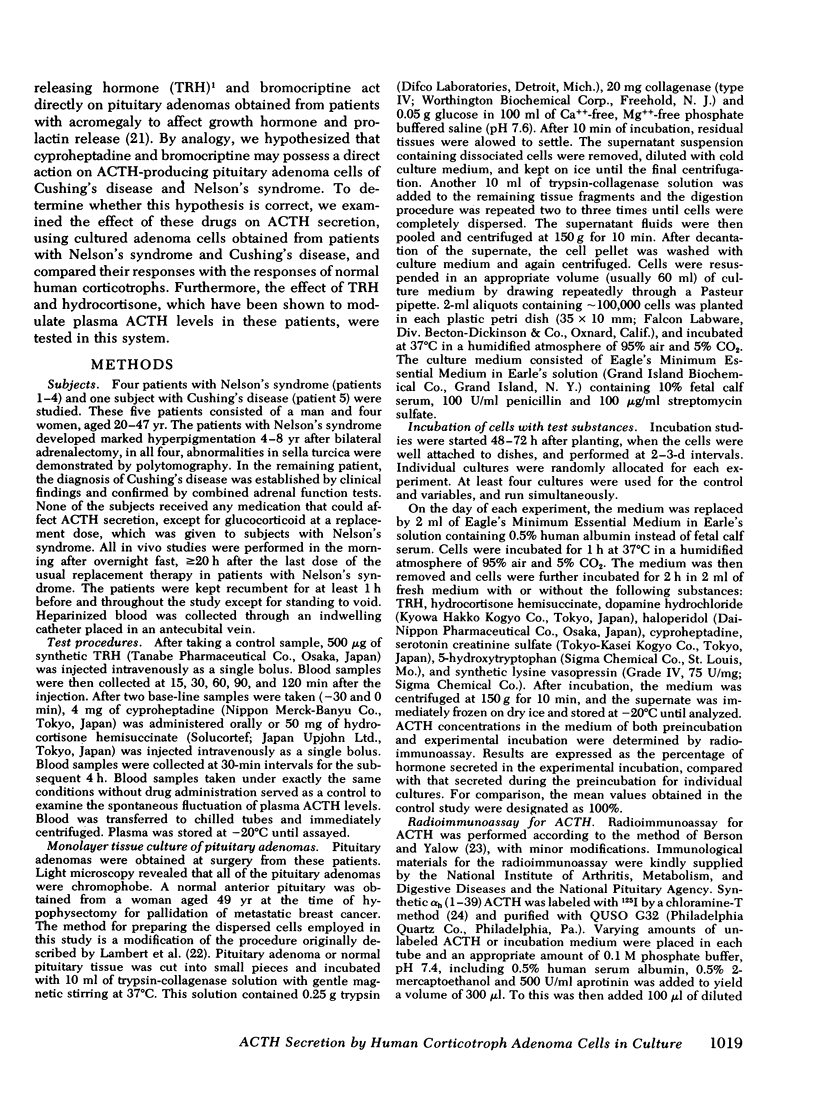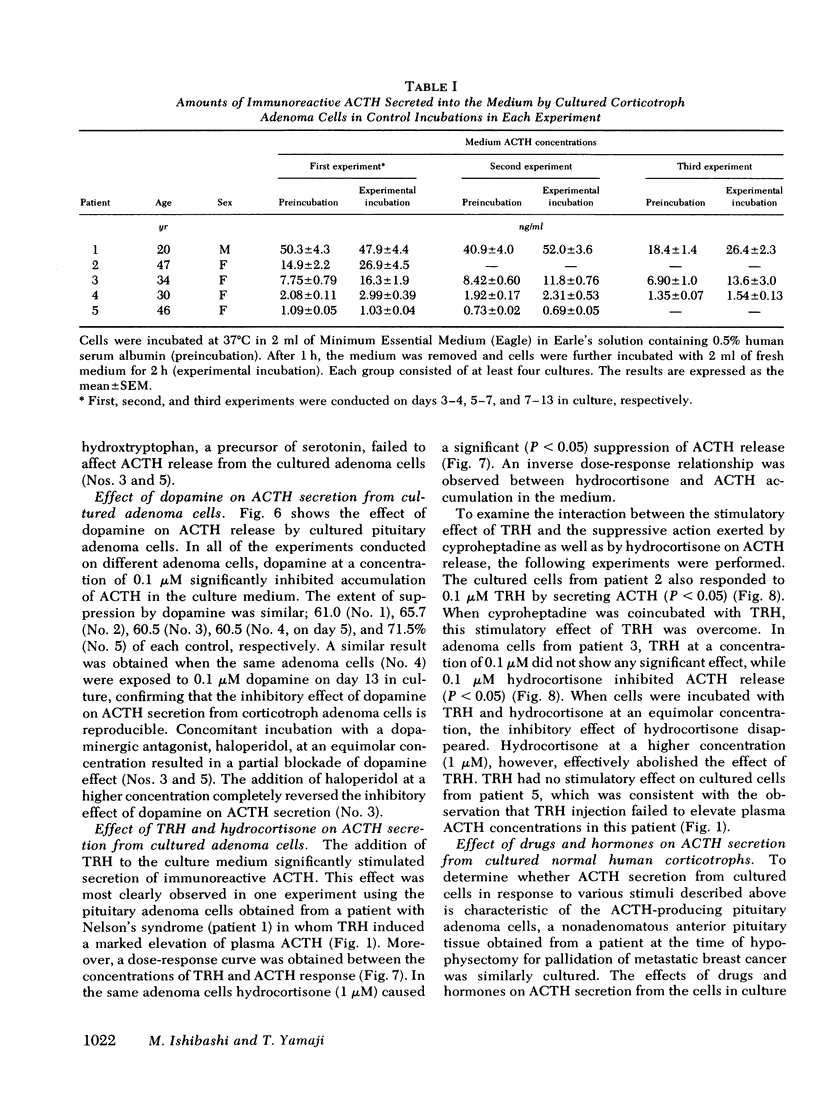Abstract
In an attempt to delineate the mechanism and the site of action of cyproheptadine and dopaminergic agonists as well as hormones including thyrotropin-releasing hormone (TRH) and hydrocortisone, the effects of these substances on ACTH secretion from corticotroph adenoma cells in culture were examined. Dispersed cells of pituitary adenomas obtained at surgery from four patients with Nelson's syndrome and one subject with Cushing's disease formed a monolayer and actively secreted ACTH into the medium. When TRH (0.1 microM) was added to the medium, a significant increase in ACTH secretion was demonstrated by adenoma cells from two patients who responded to TRH preoperatively. Moreover, a dose-response relationship between TRH concentrations and ACTH secretion was observed. Incubation of cells with cyproheptadine (1 or 0.1 microM) resulted in a significant decrease in ACTH release, and inhibited stimulation produced by TRH in one experiment. This effect of cyproheptadine was blocked when equimolar concentrations of serotonin was coincubated, whereas serotonin by itself did not affect ACTH secretion. Dopamine (0.1 microM) lowered ACTH accumulation in the medium, which was blocked by the addition of haloperidol. When hydrocortisone was added to the culture, dose-dependent suppression of ACTH secretion was demonstrated. TRH at an equimolar concentration reversed this effect, but, failed to overcome the inhibition induced by a higher concentration of hydrocortisone in cells from one adenoma studied. Cultured normal corticotrophs obtained from a patient with metastatic breast cancer, on the other hand, did not show any response to these substances, except for hydrocortisone. We suggest that TRH, cyproheptadine, dopamine affect ACTH secretion in patients with ACTH-producing pituitary adenomas by their direct action on the adenoma.
Full text
PDF









Selected References
These references are in PubMed. This may not be the complete list of references from this article.
- Allgrove J., Husband P., Brook C. G. Cushing's disease: failure of treatment with cyproheptadine. Br Med J. 1977 Mar 12;1(6062):686–687. doi: 10.1136/bmj.1.6062.686-a. [DOI] [PMC free article] [PubMed] [Google Scholar]
- Ambrosi B., Gaggini M., Secchi F., Faglia G. Lack of effect of antiserotoninergic and/or dopaminergic treatment in patients with pituitary-dependent Cushing's syndrome. Horm Metab Res. 1979 Apr;11(4):318–319. doi: 10.1055/s-0028-1095778. [DOI] [PubMed] [Google Scholar]
- Barnes P., Shaw K., Ross E. Cushing's disease: Successful treatment with cyproheptadine. Lancet. 1977 May 28;1(8022):1148–1149. doi: 10.1016/s0140-6736(77)92402-3. [DOI] [PubMed] [Google Scholar]
- Benker G., Hackenberg K., Hamburger B., Reinwein D. Effects of growth hormone release-inhibiting hormone and bromocryptine (CB 154) in states of abnormal pituitary-adrenal function. Clin Endocrinol (Oxf) 1976 Mar;5(2):187–190. doi: 10.1111/j.1365-2265.1976.tb02831.x. [DOI] [PubMed] [Google Scholar]
- Berson S. A., Yalow R. S. Radioimmunoassay of ACTH in plasma. J Clin Invest. 1968 Dec;47(12):2725–2751. doi: 10.1172/JCI105955. [DOI] [PMC free article] [PubMed] [Google Scholar]
- Bigos S. T., Robert F., Pelletier G., Hardy J. Cure of Cushing's disease by transsphenoidal removal of a microadenoma from a pituitary gland despite a radiographically normal sella turcica. J Clin Endocrinol Metab. 1977 Dec;45(6):1251–1260. doi: 10.1210/jcem-45-6-1251. [DOI] [PubMed] [Google Scholar]
- Desbuquois B., Aurbach G. D. Use of polyethylene glycol to separate free and antibody-bound peptide hormones in radioimmunoassays. J Clin Endocrinol Metab. 1971 Nov;33(5):732–738. doi: 10.1210/jcem-33-5-732. [DOI] [PubMed] [Google Scholar]
- Fleischer N., Rawls W. E. ACTH synthesis and release in pituitary monolayer culture: effect of dexamethasone. Am J Physiol. 1970 Aug;219(2):445–448. doi: 10.1152/ajplegacy.1970.219.2.445. [DOI] [PubMed] [Google Scholar]
- Gershengorn M. C., Arevalo C. O., Geras E., Rebecchi M. J. Thyrotropin-releasing hormone stimulation of adrenocorticotropin production by mouse pituitary tumor cells in culture: possible model for anomalous release of adrenocorticotropin by thyrotropin-releasing hormone in some patients with Cushing's disease and Nelson's syndrome. J Clin Invest. 1980 Jun;65(6):1294–1300. doi: 10.1172/JCI109792. [DOI] [PMC free article] [PubMed] [Google Scholar]
- Gonzalez-Luque A., L'age M., Dhariwal A. P., Yates F. E. Stimulation of corticotropin release by corticotropin-releasing factor (CRF) or by vasopressin following intrapituitary infusions in unanesthetized dogs: inhibition of the responses by dexamethasone. Endocrinology. 1970 May;86(5):1134–1142. doi: 10.1210/endo-86-5-1134. [DOI] [PubMed] [Google Scholar]
- HUNTER W. M., GREENWOOD F. C. Preparation of iodine-131 labelled human growth hormone of high specific activity. Nature. 1962 May 5;194:495–496. doi: 10.1038/194495a0. [DOI] [PubMed] [Google Scholar]
- Ishibashi M., Yamaji T. Effect of thyrotropin-releasing hormone and bromoergocriptine on growth hormone and prolactin secretion in perfused pituitary adenoma tissues of acromegaly. J Clin Endocrinol Metab. 1978 Dec;47(6):1251–1256. doi: 10.1210/jcem-47-6-1251. [DOI] [PubMed] [Google Scholar]
- Kennedy A. L., Sheridan B., Montgomery D. A. ACTH and cortisol response to bromocriptine, and results of long-term therapy, in Cushing's disease. Acta Endocrinol (Copenh) 1978 Nov;89(3):461–468. doi: 10.1530/acta.0.0890461. [DOI] [PubMed] [Google Scholar]
- Krieger D. T., Amorosa L., Linick F. Cyproheptadine-induced remission of Cushing's disease. N Engl J Med. 1975 Oct 30;293(18):893–896. doi: 10.1056/NEJM197510302931802. [DOI] [PubMed] [Google Scholar]
- Krieger D. T., Condon E. M. Cyproheptadine treatment of Nelson's syndrome: restoration of plasma ACTH circadian periodicity and reversal of response to TRF. J Clin Endocrinol Metab. 1978 Feb;46(2):349–352. doi: 10.1210/jcem-46-2-349. [DOI] [PubMed] [Google Scholar]
- Krieger D. T., Luria M. Effectiveness of cyproheptadine in decreasing plasma ACTH concentrations in Nelson's syndrome. J Clin Endocrinol Metab. 1976 Nov;43(5):1179–1182. doi: 10.1210/jcem-43-5-1179. [DOI] [PubMed] [Google Scholar]
- Krieger D. T., Luria M. Plasma ACTH and cortisol responses to TRF, vasopressin or hypoglycemia in cushing's disease and nelson's syndrome. J Clin Endocrinol Metab. 1977 Feb;44(2):361–368. doi: 10.1210/jcem-44-2-361. [DOI] [PubMed] [Google Scholar]
- Krieger D. T. Serotonin regulation of ACTH secretion. Ann N Y Acad Sci. 1977 Oct 28;297:527–535. doi: 10.1111/j.1749-6632.1977.tb41880.x. [DOI] [PubMed] [Google Scholar]
- Lagerquist L. G., Meikle A. W., West C. D., Tyler F. H. Cushing's disease with cure by resection of a pituitary adenoma. Evidence against a primary hypothalamic defect. Am J Med. 1974 Nov;57(5):826–830. doi: 10.1016/0002-9343(74)90857-2. [DOI] [PubMed] [Google Scholar]
- Lambert A. E., Blondel B., Kanazawa Y., Orci L., Renold A. E. Monolayer cell culture of neonatal rat pancreas: light microscopy and evidence for immunoreactive insulin synthesis and release. Endocrinology. 1972 Jan;90(1):239–248. doi: 10.1210/endo-90-1-239. [DOI] [PubMed] [Google Scholar]
- Lamberts S. W., Birkenhäger J. C. Bromocriptine in Nelson's syndrome and Cushing's disease. Lancet. 1976 Oct 9;2(7989):811–811. doi: 10.1016/s0140-6736(76)90656-5. [DOI] [PubMed] [Google Scholar]
- Lamberts S. W., Birkenhäger J. C. Effect of bromocriptine in pituitary-dependent Cushing's syndrome. J Endocrinol. 1976 Aug;70(2):315–316. doi: 10.1677/joe.0.0700315. [DOI] [PubMed] [Google Scholar]
- Lamberts S. W., Klijn J. G., de Quijada M., Timmermans H. A., Uitterlinden P., de Jong F. H., Birkenhäger J. C. The mechanism of the suppressive action of bromocriptine on adrenocorticotropin secretion in patients with Cushing's disease and Nelson's syndrome. J Clin Endocrinol Metab. 1980 Aug;51(2):307–311. doi: 10.1210/jcem-51-2-307. [DOI] [PubMed] [Google Scholar]
- Letter: Cyproheptadine for pituitary disorders. N Engl J Med. 1976 Aug 12;295(7):394–395. doi: 10.1056/NEJM197608122950715. [DOI] [PubMed] [Google Scholar]
- Letter: Cyproheptadine for pituitary disorders. N Engl J Med. 1976 Aug 12;295(7):394–395. doi: 10.1056/NEJM197608122950715. [DOI] [PubMed] [Google Scholar]
- Mashiter K., Adams E. F., Gillies G., Van Noorden S., Ratter S. Adrenocorticotropin and lipotropin secretion by dispersed cell cultures of a human corticotropic adenoma: effect of hypothalamic extract, arginine vasopressin, hydrocortisone, and serotonin. J Clin Endocrinol Metab. 1980 Sep;51(3):566–572. doi: 10.1210/jcem-51-3-566. [DOI] [PubMed] [Google Scholar]
- More on cyproheptadine in Cushing's disease. N Engl J Med. 1977 Mar 10;296(10):576–577. doi: 10.1056/NEJM197703102961022. [DOI] [PubMed] [Google Scholar]
- O'Mullane N., Walker B., Jefferson J., Hipkin L., Diver M., Davis C. Lack of effect of bromocriptine on ACTH levels in patients with bilateral adrenalectomy for pituitary-dependent Cushing's syndrome. J Endocrinol Invest. 1978 Oct;1(4):355–357. doi: 10.1007/BF03350982. [DOI] [PubMed] [Google Scholar]
- Pearce C. J., Isaacs A. J., Gomez J. Treatment of Cushing's disease with cyproheptadine. Lancet. 1977 Jun 25;1(8026):1368–1369. doi: 10.1016/s0140-6736(77)92585-5. [DOI] [PubMed] [Google Scholar]
- Pieters G. F., Smals A. G., Benraad T. J., Kloppenborg P. W. Plasma cortisol response to thyrotropin-releasing hormone and luteinizing hormone-releasing hormone in Cushing's disease. J Clin Endocrinol Metab. 1979 May;48(5):874–876. doi: 10.1210/jcem-48-5-874. [DOI] [PubMed] [Google Scholar]
- Rees L. H., Cook D. M., Kendall J. W., Allen C. F., Kramer R. M., Ratcliffe J. G., Knight R. A. A radioimmunoassay for rat plasma ACTH. Endocrinology. 1971 Jul;89(1):254–261. doi: 10.1210/endo-89-1-254. [DOI] [PubMed] [Google Scholar]
- Russell S. M., Dhariwal A. P., McCann S. M., Yates F. E. Inhibition by dexamethasone of the in vivo pituitary response to corticotropin-releasing factor (CRF). Endocrinology. 1969 Sep;85(3):512–521. doi: 10.1210/endo-85-3-512. [DOI] [PubMed] [Google Scholar]
- Salassa R. M., Laws E. R., Jr, Carpenter P. C., Northcutt R. C. Transsphenoidal removal of pituitary microadenoma in Cushing's disease. Mayo Clin Proc. 1978 Jan;53(1):24–28. [PubMed] [Google Scholar]
- Sayers G., Portanova R. Secretion of ACTH by isolated anterior pituitary cells: kinetics of stimulation of corticotropin-releasing factor and of inhibition by corticosterone. Endocrinology. 1974 Jun;94(6):1723–1730. doi: 10.1210/endo-94-6-1723. [DOI] [PubMed] [Google Scholar]
- Tyrrell J. B., Brooks R. M., Fitzgerald P. A., Cofoid P. B., Forsham P. H., Wilson C. B. Cushing's disease. Selective trans-sphenoidal resection of pituitary microadenomas. N Engl J Med. 1978 Apr 6;298(14):753–758. doi: 10.1056/NEJM197804062981401. [DOI] [PubMed] [Google Scholar]
- Vernikos-Danellis J., Kellar K. J., Kent D., Gonzales C., Berger P. A., Barchas J. D. Serotonin involvement in pituitary-adrenal function. Ann N Y Acad Sci. 1977 Oct 28;297:518–526. doi: 10.1111/j.1749-6632.1977.tb41879.x. [DOI] [PubMed] [Google Scholar]


